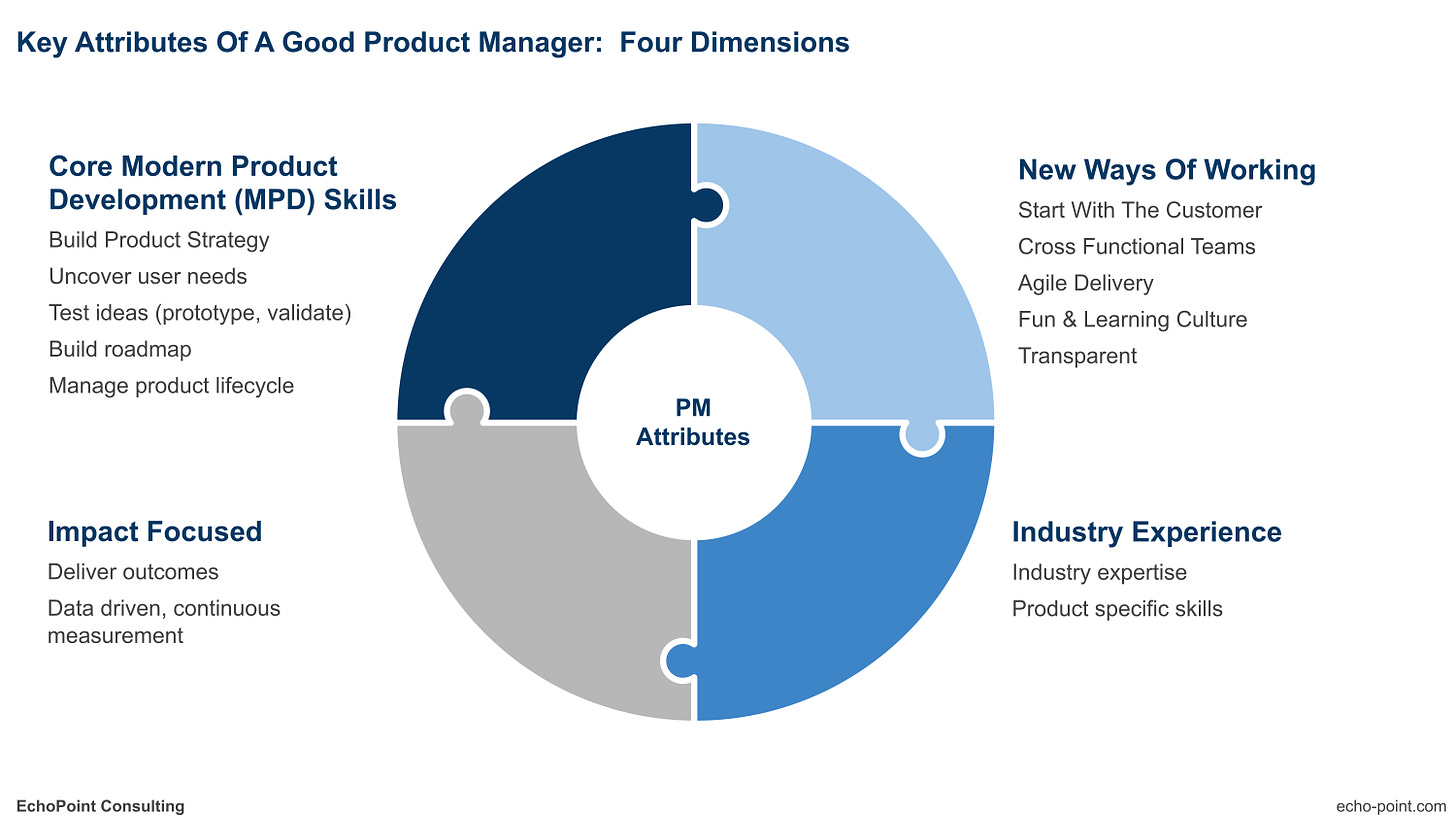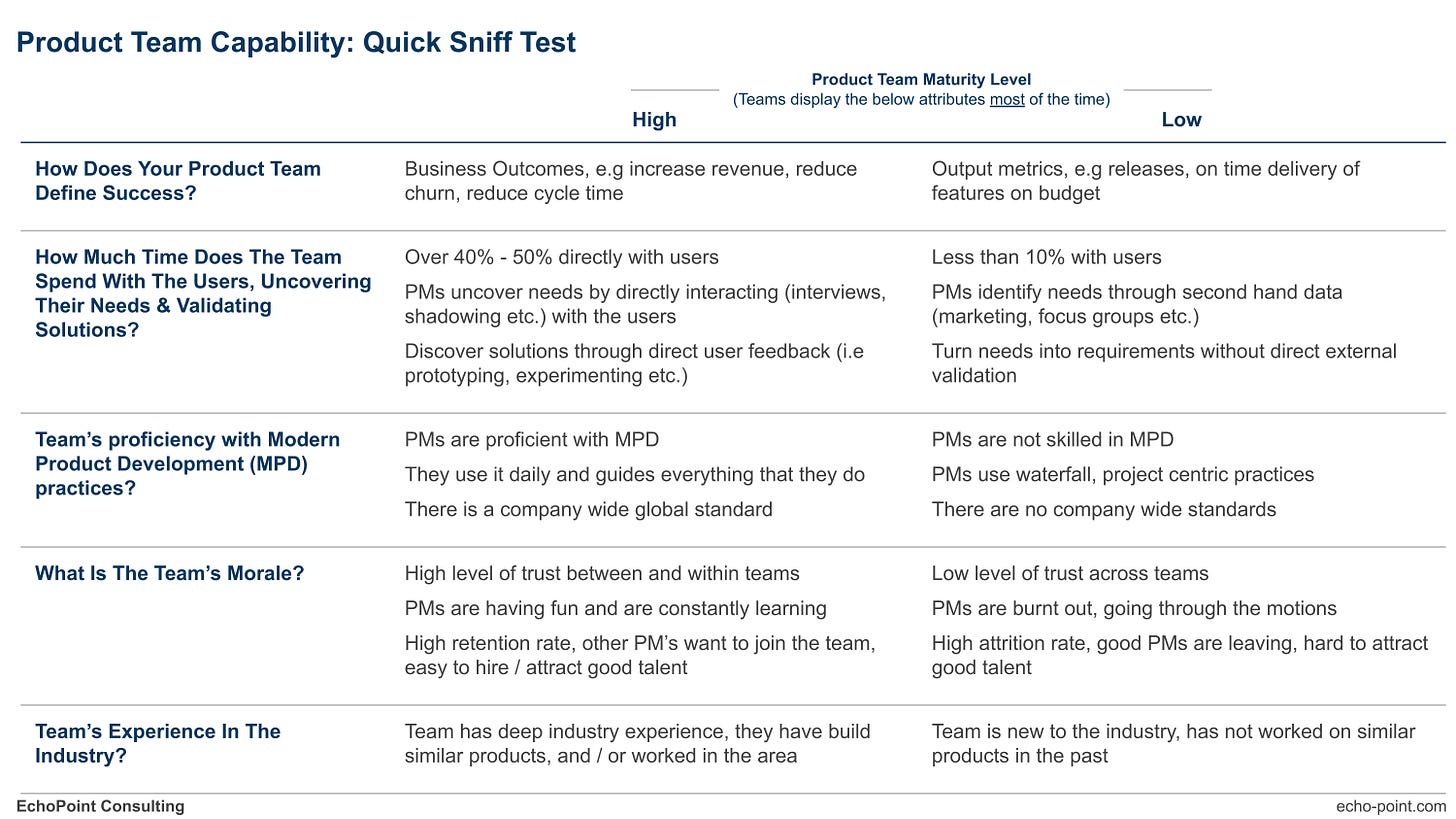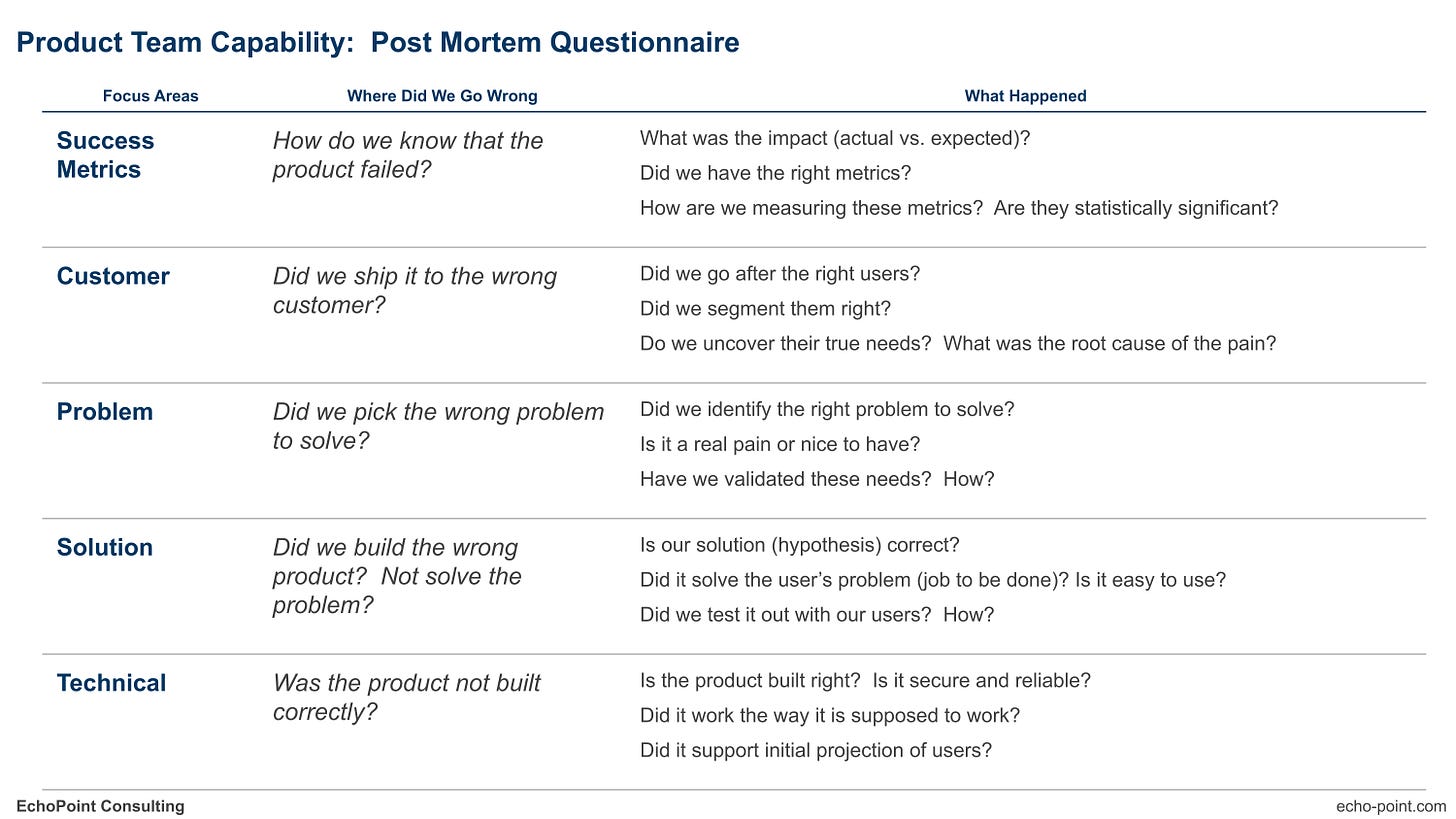Success = Great Products.
As a new product leader, you have been hired / promoted to do one job – build products.
But not any product. Releasing something…anything does not cut it anymore.
It has to be a great product. It has to be a product and / or an experience that customers will love, is easy to use, and drive business impact.
And if that is not hard enough. You also need to do it at scale, across multiple products, and in record time.
Do it well and you will be a hero. Mess it up and you will be looking for a new job in 18 months.
So How Do You Build A Portfolio Of Great Products? Where Do You Begin?
The most successful new leaders start with assessing the capability of their current product managers.
Why?
Because it provides them with,
- A first real glimpse of what they have inherited (problems and all)
- The odds of getting a great product out the door,
- The types of resources they will need to hire to augment the team, and
- The nature of transformation / change that they will need to install
For Example, The New Head Of Product At A Leading Telecom Spent His First 30 Days Evaluating His Current Team.
In those 30 days, he learned that he had inherited project managers and not product managers.
So his first initiatives was to build the right modern product development foundation within his team. And only after that he started making changes to the operating model and product development process.
If he had skipped assessing the team’s current capabilities, the rest of his changes would have fallen on deaf years.
Even in mature product organizations such as Google, Facebook, Apple, Amazon. Evaluating product managers is standard operating procedure for all new product leaders.
So As A New Product Leader, If You Want To Build Great Products. Start With Your Product Managers.
If your goal is to make a difference. If want to drive real impact. If you want to be amazingly successful in your new position.
Focus your first 30 days on evaluating the capabilities of your product managers.
Which Then Begs Two Questions,
First, What Does A Good Digital Product Manager Look Like?
In my experience, it comes down to the following four attributes.

1. Deep Understanding Of Modern Product Development:
The way we build digital products is radically different. Today’s product managers need to master product strategy (story telling), discovery (uncovering user’s hidden needs), experimenting (prototyping), and overseeing development (roadmaps)
2. Comfortable With New Ways Of Working:
It takes a village to bring a product to market. This requires talking directly with users, managing cross functional teams, and being transparent. And doing it all while having fun.
3. Focus On Outcome (Not Output):
Good product managers are laser focused on driving business results. To them a product launch is not the end but an opportunity to collect more data and measure their progress.
4. Industry / Product Knowledge:
Finally, industry and / or product knowledge does matter. Especially in well regulated industries like telecom, financial services, and energy.
Second, How Can You Tell If You Have Good Product Managers In Your Team?
There are a lot of options available for capability assessments.
My personal favorites are,
- Sniff Test: Quick and dirty litmus test any product leader can use at any time with their product team. It’s just 5 simple questions
- Maturity Assessment: Traditional assessment where you rate your team from 1 to 5 (novice to expert). Especially useful if you are looking to make a case to transform your product team.
- Product Postmortems: Think of it as a product audit. Not only can it tell you what you need to fix but will also highlight the gaps in your team.
Regardless of which one you choose to use, the goal is the same. Evaluate your current product management capabilities, identify gaps, and then figure out how to plug them.
Let’s dig deep into each option,
Option 1: Sniff Test – Cheap, Fast, And Good Enough
This test is a great way to get a quick pulse on the capabilities of your current product managers.

It test the team’s maturity across five key categories – from outcome focused, user centricity, product development proficiency, morale, and industry experience.
While this is not a complete maturity assessment. It does provide good insight quickly on your newly inherited team’s maturity.
I use this test with my clients all the time.
Option 2: Maturity Assessment – Holistic & Detailed
If you are looking for a more traditional maturity assessment, then this is it.
Enclosed is a typical output that you can expect from this study.


Unlike the previous test, this assesses the entire organization across all of the 16 “what Does Good Look Like” attributes.
The benefit of using a more robust maturity assessment is two fold.
First, it provides you with an organization wide maturity score – Product Development Index (PDI). Both at the aggregate and granular level.
Second, the PDI can then be used to determine where you need to invest in order to improve you maturity.
Option 3: Product Post Mortems – Audit Work To Identify Skill Gaps
Product audits come in many flavors. This is the one I tend to use most of the time.

The reason I like this method to assess team capability is because it takes an indirect approach.
Instead of evaluating the team capability in a vacuum (like the previous two options). The audit relies on assessing the team’s actual work. Which means that there is no place to hide. And you end up with the most accurate picture.
The product audit, if used correctly, can be a powerful diagnostic tool.
Deciding When To Use What Option Can Get Tricky. Here Is A Quick Cheat Sheet For New Product Leaders.
Option 1: Sniff Test
Use this test if you would like to come to speed quickly on your team’s capability. It’s simple, it’s efficient, and it tells you where to dig.
The results may not be as robust as the other two. But it will be directionally correct.
Option 2: Maturity Assessment
Of all the three assessment options, this approach takes the longest and requires the biggest lift. But it is also the most thorough.
Which is why, this is best used when new leaders want to make a more formal business case for transformation.
Option 3: Product Post Mortems
As for the product audits, they work great post launch. Especially if the product is failing to deliver the desired results.
If used correctly, this stuff works like x-ray to highlight not only skill gaps but also process, operating model, and organizational inefficiencies.
One More Thing. So Far We Have Focused On New Product Leaders. What About Existing Leaders. Can They Use These Frameworks As Well?
The simple answer is – yes of course.
But with a few caveats.
First, since you know the team and are aware of the holes. Consider a more targeted approach. Only administer the assessments to the teams in question.
Second, for a bigger bang for your buck. Look into using these assessments regularly. For example, use the product audit question as a stage gate to product funding.
Third, feel free to mix and match. I know a chief product officer, who has combined the sniff test and post mortem to identify root causes.
What To Do Next. Well That Depends On The Assessment’s Output.
If you have inherited a bunch of rock stars. Consider yourself lucky.
On the contrary, if you find out that you have a team that has never built a product before. Then your work is cut out for you.
And if so, then you will have to consider transformation path that includes not just upskilling the team, but also changing operating model, team compositions, process etc.
It’s a lot of work. But that is where the fun begins.
Happy Building!!

